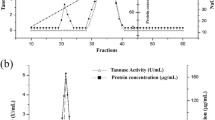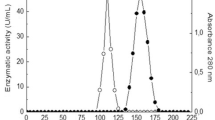Abstract
Tannase from Aspergillus awamori MTCC 9299 was purified using ammonium sulfate precipitation followed by ion-exchange chromatography. A purification fold of 19.5 with 13.5% yield was obtained. Temperature of 30 °C and pH of 5.5 were found optimum for tannase activity. The effects of metals and organic solvents on the activity of tannase were also studied. Metal ions Mg+2, Mn+2, Ca+2, Na+, and K+ stimulated the tannase activity, while Cu+2, Fe+3, and Co+2 acted as inhibitors of the enzyme. The addition of organic solvents like acetic acid, isoamylalcohol, chloroform, isopropyl alcohol, and ethanol completely inhibited the enzyme activity. However, butanol and benzene increased the enzyme activity.




Similar content being viewed by others
References
Lekha, P. K., & Lonsane, B. K. (1997). Production and application of tannin acyl hydralose: state of the art. Advances in Applied Microbiology, 44, 215–260.
Mahapatra, K., Nanda, R. K., Bag, S. S., Banerjee, R., Pandey, A., & Szakacs, G. (2005). Purification, characterization and some studies on secondary structure of tannase from Aspergillus awamori nakazawa. Process Biochemistry, 40, 3251–3254.
Seth, M., & Chand, S. (2000). Biosynthesis of tannase and hydrolysis of tannins to gallic acid by Aspergillus awamori—optimisation of process parameters. Process Biochemistry, 36, 39–44.
Mukherjee, G., & Banerjee, R. (2006). Effects of temperature, pH and additives on the activity of tannase produced by a co-culture of Rhizopus oryzae and Aspergillus foetidus. World Journal of Microbiology & Biotechnology, 22, 207–211.
Aguilar, C. N., & Gutierrez-Sanchez, G. (2001). Review: sources properties, applications and potential uses of tannin acyl hydrolase. International Journal of Food Science & Technology, 7, 373–382.
Kar, B., Banerjee, R., & Bhattacharyya, B. C. (2003). Effect of additives on the behavioural properties of tannin acyl hydrolase. Process Biochemistry, 38, 1285–1293.
Saborowski, R., Sahling, G., Navarette del Toro, M. A., Walter, I., & Garcia-Carreno, F. L. (2004). Stability and effects of organic solvents on endopeptidases from thegastric fluid of the marine crab Cancer pagurus. Journal of Molecular Catalysis. B, Enzymatic, 30, 109–118.
Bradoo, S., Gupta, R., & Saxena, R. K. (1996). Screening for extracellular tannase producing fungi: development of a rapid and simple plate assay. Journal of General and Applied Microbiology, 42, 325–329.
Mondal, K. C., Banerjee, D., Jana, M., & Pati, B. R. (2001). Colorimetric assay method for determination of the tannase activity. Analytical Biochemistry, 295, 168–171.
Bradford, M. M. (1976). A rapid and sensitive method for the quantitation of microgram quantities of protein utilizing the principle of protein-dye binding. Analytical Biochemistry, 72, 248–254.
Mahendran, B., Raman, N., & Kim, D. J. (2006). Purification and characterization of tannase from Paecilomyces variotii: hydrolysis of tannic acid using immobilized tannase. Applied Microbiology and Biotechnology, 70, 444–450.
Kasieczka-Burnecka, M., Karina, K., Kalinowska, H., Knap, M., & Turkiewicz, M. (2007). Purification and characterization of two cold-adapted extracellular tannin acyl hydrolases from an Antarctic strain Verticillium sp. P9. Applied Microbiology and Biotechnology, 77, 77–89.
Sharma, S., Agarwal, L., & Saxena, R. K. (2008). Purification, immobilization and characterization of tannase from Penicillium variable. Biores Technology, 99, 2244–2251.
Sabu, A., Kiran, S. G., & Pandey, A. (2005). Purification and characterization of tannin acyl hydrolose from Aspergillus niger ATCC 16620. Journal of Food Technology and Biotechnology, 2, 133–138.
Kumar, R., Sharma, J., & Singh, R. (2007). Production of tannase from Aspergillus ruber under solid-state fermentation using jamun (Syzygium cumini) leaves. Microbiological Research, 162, 384–390.
Rodriguez, H., Rivas, B., Gomez-Cordoves, C., & Munoz, R. (2008). Characterization of tannase activity in cell free extracts of Lactobacillus plantarun CECT748. International Journal of Food Microbiology, 121, 92–98.
Zaks, A., & Klibnov, A. M. (1985). Enzyme-catalyzed processes in organic solvents. Proceedings of the National Academy of Sciences of the United States of America, 82, 3192–3196.
Fridovichi, I. (1996). Some effects of organic solvents on the reaction kinetics of milk xanthine oxidase. Journal of Biological Chemistry, 241, 3624–3629.
Author information
Authors and Affiliations
Corresponding author
Rights and permissions
About this article
Cite this article
Chhokar, V., Sangwan, M., Beniwal, V. et al. Effect of Additives on the Activity of Tannase from Aspergillus awamori MTCC9299. Appl Biochem Biotechnol 160, 2256–2264 (2010). https://doi.org/10.1007/s12010-009-8813-7
Received:
Accepted:
Published:
Issue Date:
DOI: https://doi.org/10.1007/s12010-009-8813-7




